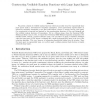84 search results - page 16 / 17 » On the Security Loss in Cryptographic Reductions |
ASIACRYPT
2011
Springer
12 years 6 months ago
2011
Springer
A cryptographic assumption is the (unproven) mathematical statement that a certain computational problem (e.g. factoring integers) is computationally hard. The leakage-resilience l...
EUROCRYPT
2010
Springer
13 years 9 months ago
2010
Springer
We present a family of verifiable random functions which are provably secure for exponentially-large input spaces under a non-interactive complexity assumption. Prior construction...
GLVLSI
2009
IEEE
2009
IEEE
Physical unclonable function and true random number generator: a compact and scalable implementation
13 years 9 months ago
Physical Unclonable Functions (PUF) and True Random Number Generators (TRNG) are two very useful components in secure system design. PUFs can be used to extract chip-unique signat...
MSWIM
2009
ACM
14 years 23 days ago
2009
ACM
Host Identity Protocol (HIP) decouples IP addresses from higher layer Internet applications by proposing a new, cryptographic namespace for host identities. HIP has great potentia...
CCS
2004
ACM
13 years 11 months ago
2004
ACM
Access control can be used to ensure that database queries pertaining to sensitive information are not answered. This is not enough to prevent users from learning sensitive inform...


